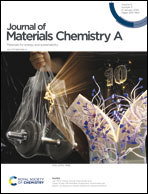Super-tough self-healable multiphasic supramolecular plastic via sequence-biased statistical copolymerization†
Abstract
Achieving both mechanical robustness and facile healing in self-healable supramolecular materials remains a challenge. This study presents a complementary design for a self-healable supramolecular plastic material, namely, ureidopyrimidinone (UPy)-end functionalized star poly(ε-caprolactone-co-ε-decalactone) (USPCD), based on the kinetics of sequence-biased statistical copolymerization, which depend on the bulkiness of monomers. The copolymerization results in phase separation, wherein the soft phases bear UPy hydrogen bonds and the hard phases contain crystalline bonds. The soft phases can induce a dynamic exchange of UPy moieties and consequent facile healing, whereas the hard phases can contribute to mechanical versatility. Eventually, the composition and sequence control of repeating units in the USPCD significantly affect the mechanical and healing characteristics. USPCD92, with ∼8 mol% poly(ε-decalactone) (PDL) adjacent to the UPy-end moieties, exhibits a super-tough plastic behavior (∼44 MJ m−3), rather than rubber-like behavior, with an excellent healing performance of ∼99% at 50 °C after 10 min treatment.



 Please wait while we load your content...
Please wait while we load your content...